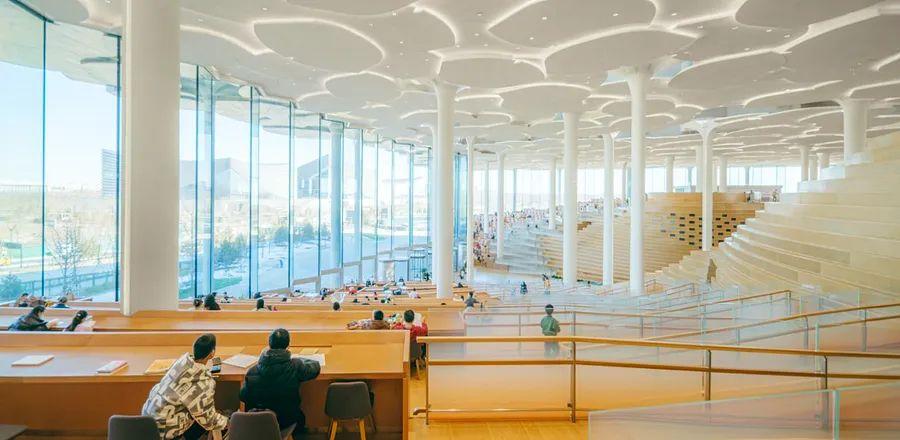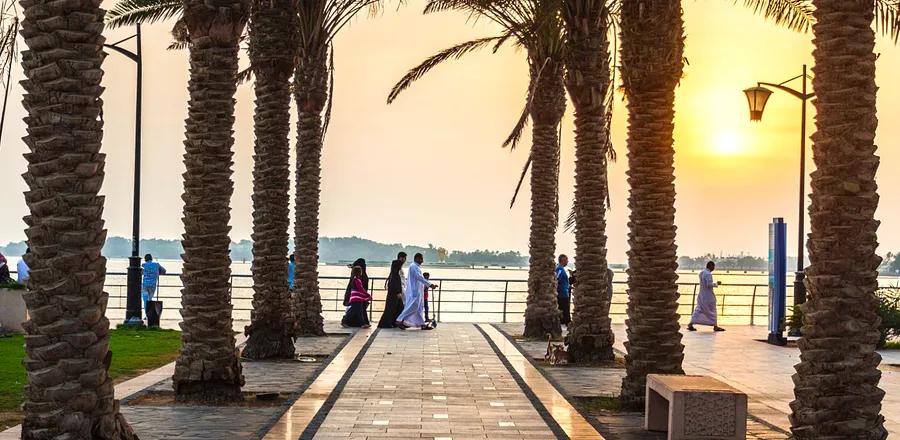10 Architectural Marvels You Must See This Year

With pandemic delays behind us, the architecture world is booming again. Renowned and rising firms—from Studio Gang's female-led team in the US and France to Norway’s innovative Snøhetta—are unveiling groundbreaking hotels, postindustrial art hubs, timber-clad airport terminals, and eco-conscious structures. These 10 recently opened or soon-to-open projects are so extraordinary, they deserve a dedicated trip.
Beijing Public Library
Beijing, China
Snøhetta, known for designing Egypt's Bibliotheca Alexandrina and Calgary’s Central Library, has created yet another masterpiece: a sunlit, glass-walled library in Beijing’s Tongzhou District. Featuring the world’s largest climatized reading room, this space mimics the nearby riverbanks with terraced seating and towering columns shaped like ginkgo leaves, offering visitors the feeling of reading beneath a forest canopy.

Photos by Alan Williams
Kunstsilo
Kristiansand, Norway
Kunstsilo is Norway's response to London’s Tate Modern or Cape Town’s Zeitz MOCAA. This postindustrial museum retains its 1935 functionalist silo structure, once holding 15,000 tons of grain. Barcelona-based architects Mestres Wåge Arquitectes, BAX, and Mendoza Partida revamped it into a vast waterfront art space, with a soaring 70-foot atrium. It now showcases the world’s largest collection of Nordic modernist art, along with Norwegian contemporary art and crafts. Kristiansand, Norway’s sunniest city, boasts sandy beaches, a charming old town, and an archipelago of over 1,000 islands, about 200 miles from Oslo.

Courtesy of Studio Gang
Populus Hotel
Denver, Colorado
Touted as the U.S.'s first carbon-positive hotel, the Populus is Studio Gang’s nature-inspired creation, led by Jeanne Gang. Known for their daring new wing at New York’s American Museum of Natural History, the firm continues to explore organic shapes with this hotel, set to open in late 2024. The flatiron-like structure takes its name from the aspen tree, Populus tremuloides. The eye-shaped windows provide natural shading and direct rainwater, while the green roof will host local plants, inviting native wildlife and insects.
The hotel will achieve carbon positivity—removing more CO2 than it produces—by using local and recycled materials, renewable energy, and a biodigester to compost food waste. Its boldest initiative? Planting one tree for every night you stay, with 70,000 trees already planted in Gunnison County, Colorado, during construction.

Photo by Hufton+Crow
One Za’abeel
Dubai, United Arab Emirates
Dubai's skyline is already iconic, but this H-shaped twin tower by Japan's Nikken Sekkei, officially opened in February 2024, is a standout. It houses offices, residences, the One&Only hotel, the fitness-focused SIRO hotel, and top-tier restaurants from chefs like Anne-Sophie Pic. The most remarkable feature is The Link, a 754-foot-long horizontal bridge between the towers. Extending 216 feet past the building and hovering over 300 feet above the street, this engineering marvel earned a Guinness World Record for the longest cantilevered building in the world.

Photo by Ema Peter/Port of Portland
Portland International Airport
Portland, Oregon
PDX’s newly revamped terminal, which opened in summer 2024 after a $2.15 billion renovation by ZGF Architects, embraces Pacific Northwest design and materials. The highlight is the nine-acre timber roof, crafted from sustainably sourced Douglas fir from nearby forests. Forty-nine skylights flood the space with natural light, sustaining 5,000 live plants, including 72 full-grown trees. A nod to nostalgia, the iconic green patterned carpet, beloved by locals since 1987 and removed in 2015, makes a return in select areas of the terminal, perfect for snapping a #PDXcarpetshoefie.

Photo by Ademola Olaniran Jide Atobatele
John Randle Centre for Yoruba Culture & History
Lagos, Nigeria
In 1928, John Randle, one of the first West Africans with a British medical degree, built a public pool to rival the nearby colonizers' exclusive club. This bold symbol of African pride fell into disrepair and remained unused since the 1970s. Now, Studio Imagine Simply Architecture (SI.SA) is revitalizing the site into a cultural hub. Principal architect Seun Oduwole describes the design as ‘unapologetically Yoruba.’ The vibrant, organic structure honors ancient Yoruba crafts like metalwork and weaving. The center will feature exhibits on Yoruba wood-carving, fashion, and storytelling, plus a library, gift shop, restaurant, a new public pool, and a sloping green roof for picnics. Don't miss the Nike Art Gallery by textile designer Chief Nike Davies-Okundaye and the Kalakuta Museum in Fela Kuti's former home.

Photo by Creativity lover/Shutterstock
Grand Egyptian Museum
Giza, Egypt
After countless delays, the long-awaited museum is finally poised to open, and when it does, it will be the world’s largest archaeological museum, featuring over 100,000 artifacts, including treasures from Tutankhamun’s tomb. Designed by Irish firm Heneghan Peng Architects in 2003, the colossal structure stands on a desert plateau between Cairo and the Great Pyramid of Giza. The grand atrium is dominated by a 36-foot-tall statue of Pharaoh Rameses II, crafted over 3,200 years ago. Highlights also include a monumental staircase that acts as a timeline of Ancient Egypt, with a glass wall at the top offering breathtaking views of the pyramids.

Photo by Klaus Helbig
Museum Reinhard Ernst
Wiesbaden, Germany
Postwar art enthusiasts should not overlook this new museum in Wiesbaden, Germany, located about 40 minutes west of Frankfurt and conveniently accessible via the S1 S-Bahn. It showcases the personal collection of Reinhard Ernst, an industrialist who amassed his wealth in gears and motors, and now in his 70s, focuses on abstract art. The museum, housed in a minimalist white building, opened in June 2024, just weeks after the passing of its architect, Pritzker Prize–winner Fumihiko Maki. The collection includes midcentury masters like Pollock, Krasner, Stella, and Frankenthaler, as well as contemporary pieces like Katharina Grosse's vibrant glass work, 'Ein Glas Wasser, bitte.'

Courtesy of Hampi Arts Lab
Hampi Art Labs
Toranagallu, India
Situated approximately 20 miles from Hampi, a UNESCO World Heritage site known for its ancient Hindu temples and palaces in Karnataka, this newly established arts center presents a striking contrast. Crafted by Sameep Padora of sP+a, the structure features a flowing, serpentine layout of studios, galleries, and courtyard gardens, drawing inspiration from the gentle curves of the nearby Tungabhadra River. It utilizes sustainable materials, many of which are by-products from a local steelworks: excavated earth forms the concrete framework, slag waste is transformed into paving blocks, and iron oxide gives the building its unique terra-cotta coloration. While Hampi may be a journey—about six hours from Bangalore or seven from Goa—the ancient temples are essential viewing for history enthusiasts, often likened to Angkor Wat.

Courtesy of Gran Acuario Mazatlán
Gran Acuario Mazatlán
Mazatlán, Mexico
While aquariums may not typically encourage architectural innovation, this beach town on the Pacific coast embraced a bold vision with its remarkable $100 million design by Tatiana Bilbao. The architect, hailing from Mexico City, imagined Mexico’s largest aquarium—focused on marine life from the Sea of Cortez—as a “flooded ruin.” This brutalist structure, crafted from softly mauve concrete, appears to have been reclaimed by nature. As Bilbao describes it, envision the building in a distant future where rising sea levels have submerged it, only to recede, leaving behind fragments of ecosystems in open-air exhibits, including ponds and tanks. Skylights allow plants to cascade down, staircases lead into winding passages, and rooms housing tanks and ponds exude a moody, shadowy atmosphere. Picture this space as an unexpected blend of Planet of the Apes and Finding Nemo.

1

2

3

4

5
Evaluation :
5/5